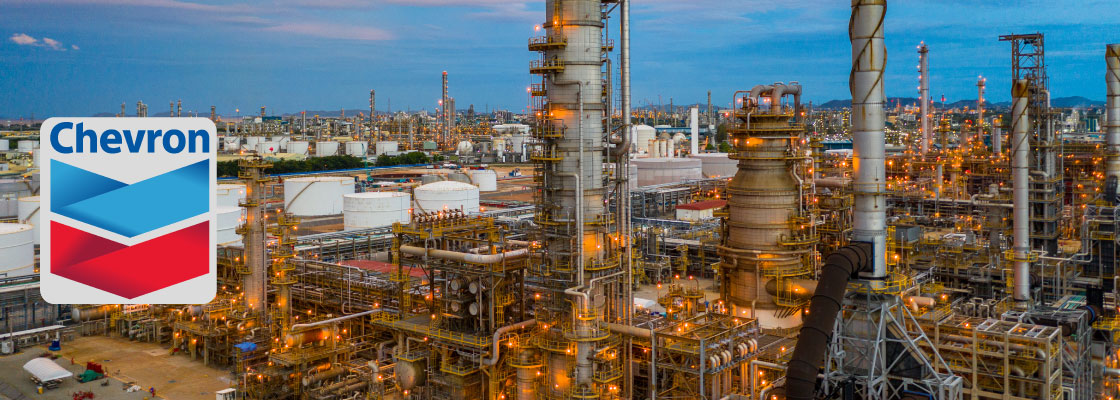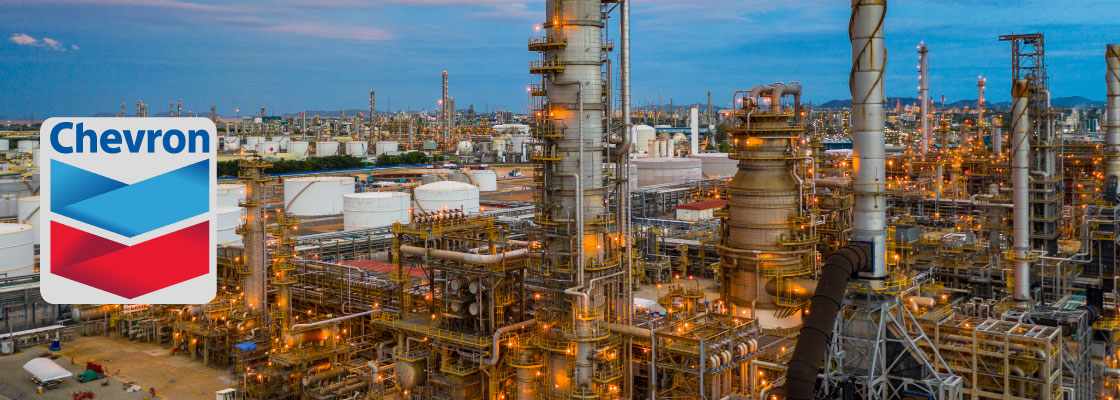Chevron Corporation (CVX) on Q2 2022 Results - Earnings Call Transcript
Operator: Good morning. My name is Katie and I will be your conference facilitator today. Welcome to Chevron’s Second Quarter 2022 Earnings Conference Call. [Operator Instructions] As a reminder, this conference call is being recorded. I will now turn the conference over to the General Manager of Investor Relations of Chevron Corporation, Mr. Roderick Green. Please go ahead. Roderick Green: Thank you, Katie. Welcome to Chevron’s second quarter 2022 earnings conference call and webcast. I am Roderick Green, GM of Investor Relations. Our CFO, Pierre Breber; and EVP of Upstream, Jay Johnson, are on the call with me today. We will refer to the slides and prepared remarks that are available on Chevron’s website. Before we get started, please be reminded that this presentation contains estimates, projections and other forward-looking statements. Please review the cautionary statement on Slide 2. Now, I will turn it over to Pierre. Pierre Breber: Thank you, Roderick, and thanks everyone for joining us today. We delivered another strong quarter, another quarter of strong financial results with ROCE over 25%, the highest since 2008. Special items this quarter include asset sale gains of $200 million and a $600 million charge to terminate early a long-term LNG regas contract at Sabine Pass. C&E for the quarter was nearly $4 billion, including inorganic spend to form our JV with Bunge. With the acquisition of REG, our total investment was $6.8 billion, more than double last year’s quarter. Strong cash flow enabled us to fund this higher level of investment, pay down debt for the fifth consecutive quarter and returned more than $5 billion to our shareholders through dividends and buybacks. Adjusted second quarter earnings were up more than $8 billion versus last year. Adjusted upstream earnings increased mainly on higher realizations partially offset by lower liftings from the end of concessions in Indonesia and Thailand. Adjusted downstream earnings increased primarily on higher refining margins. Compared with last quarter, adjusted earnings were up nearly $5 billion. Adjusted upstream earnings increased primarily on higher realizations, partially offset by tax and other items, including higher withholding taxes on TCO dividends and cash repatriations. Adjusted downstream earnings increased primarily on higher refining margins and a favorable swing in timing effects. The All Other segment was up due in part to a favorable change in the valuation of stock-based compensation. I will now turn it over to Jay. Jay Johnson: Thanks, Pierre. Second quarter oil equivalent production decreased about 7% year-on-year due to expiration of our contracts in both Indonesia and Thailand, the sale of our Eagle Ford asset and CPC curtailments impacting TCO during April. This was partially offset by shale and tight growth, primarily in the Permian. In the Permian, we are delivering on our objectives of higher returns and lower carbon. Our development costs are down about 25% since 2019 and we expect to keep them flat this year by offsetting inflation with productivity improvements. An example of simul-frac where we perform completion activities on 4 wells at a time reducing cycle time by a quarter. We continue to design, construct and operate facilities to limit methane emissions. Two of our Midland Basin sites recently earned the highest ratings from Project Canary’s independent certification program. Production is at record levels and growing in line with guidance with our royalty position, providing a distinct financial advantage for our shareholders. At TCO, the drilling program is complete and the final metering station is online. We expect to complete construction by year-end with remaining project activities, primarily focused on systems completion, commissioning and startup. Total project cost guidance is unchanged. WPMP startup is expected in the second half of next year and FGP expected timing remains first half of 2024. TCO’s operations continue to generate strong cash flow, enabling a midyear dividend with project spend decreasing we are expecting higher dividends going forward. In Australia, we shipped 87 LNG cargoes from Gorgon and Wheatstone in the first half of this year, up over 10% from last year. Our reliability benchmarks in the first quartile and we intend to stay there with an ongoing focus on operational excellence. Gorgon Stage 2, the first backfill project is on track to deliver first gas in September. Our Gulf of Mexico projects are progressing well with Ballymore receiving FID as a tieback to Blind Faith, an example of leveraging our existing infrastructure to improve returns. The Anchor hull is currently sailing from Korea and work on its top sites continues in Texas. Lastly, we recently signed agreements to export 4 million tons a year of LNG from the U.S. Gulf Coast with 1.5 million tons a year expected to start in 2026. These agreements leverage our growing U.S. natural gas production and expand our value chains in Atlantic Basin markets. Now, back to you, Pierre. Pierre Breber: Thanks, Jay. We closed the REG acquisition last month and integration is going very well. We are pleased to welcome REG’s talented employees to Chevron and CJ Warner to our Board. Our teams have already identified further commercial opportunities and we quickly acted to lower insurance and financing costs. In May, we launched our joint venture with Bunge. The JV is operating two existing crushers and evaluation work is underway to expand crush capacity and add pretreatment facilities. In carbon capture and storage, we closed on the expanded JV to develop the Bayou Bend CCS hub. The lease held by the JV is in Texas State Waters near large industrial emitters and we believe it is the first U.S. offshore lease dedicated to CCS. Also, we recently filed for a conditional use permit in Kern County, California to store CO2 emissions from one of our cogeneration plants. Now, looking ahead, in the third quarter, we expect turnarounds and downtime to reduce production in a number of locations. In downstream, planned turnarounds are primarily at our California refineries. We do not expect significant dividends from TCO or Angola LNG until the fourth quarter. Our full year guidance for affiliate dividends is unchanged, with upside potential beyond the top of the range depending on commodity prices. Also, we increased the top end of our share buyback guidance range to $15 billion per year and expect to be at that rate during the third quarter. In closing, we are executing our plans, increasing investment to grow both traditional and new energy supplies and delivering value to our stakeholders. Although commodity markets maybe volatile, our actions are consistent through the cycle and focus on our objectives to deliver higher returns and lower carbon. Back to you, Roderick. Roderick Green: That concludes our prepared remarks. We are now ready to take your questions. Please limit yourself to one question and one follow-up. We will do our best to get all your questions answered. Katie, please open the lines. Operator: Thank you. [Operator Instructions] Our first question comes from Devin McDermott with Morgan Stanley. Operator: Thank you. We will take our next question from Neil Mehta with Goldman Sachs. Operator: Thank you. We will take our next question from Jeanine Wai with Barclays. Operator: We will take our next question from Doug Leggate with Bank of America. Operator: Thank you. We will take our next question from John Royall with JPMorgan. Operator: Thank you. We will take our next question from Jason Gabelman with Cowen. Operator: Thank you. We will take our next question from Manav Gupta with Credit Suisse. Operator: Thank you. We will take our next question from Biraj Borkhataria with RBC. Operator: Thank you. We will take our next question from Sam Margolin with Wolfe Research. Operator: Thank you. We will take our next question from Irene Himona with Societe Generale. Operator: Thank you. We will take our next question from Paul Cheng with Scotiabank. Operator: Thank you. We will take our last question from Ryan Todd with Piper Sandler. Roderick Green: Thanks Ryan. I would like to thank everyone for your time today. We appreciate your interest in Chevron and everyone’s participation on today’s call. Please stay safe and healthy. Katie, back to you. Operator: Thank you. This concludes Chevron’s second quarter 2022 conference call. You may now disconnect.
Chevron Corporation's Strategic Initiatives and Market Performance
- Scotiabank maintains a "Sector Perform" rating for Chevron Corporation (NYSE:CVX), with a raised price target from $160 to $165.
- The inauguration of the Engineering and Innovation Excellence Center (ENGINE) in Bengaluru, India, aims to boost Chevron's digital and artificial intelligence capabilities.
- Despite positive developments, Chevron's stock price has seen a slight decrease, with a current price of $152.55, indicating some market volatility.
Chevron Corporation (NYSE:CVX), a major player in the global energy sector, is involved in various activities, including oil and gas exploration, production, refining, and marketing. Competing with other energy giants like ExxonMobil and BP, Chevron has been a focus for investors. On October 9, 2025, Scotiabank maintained its "Sector Perform" rating for Chevron, suggesting investors hold onto their shares. At that time, Chevron's stock was priced at $152.57.
Scotiabank also raised Chevron's price target from $160 to $165, indicating a positive outlook for the company's future performance. This adjustment reflects confidence in Chevron's strategic initiatives, such as the recent inauguration of a 312,000-square-foot facility in Bengaluru, India. This facility, known as the Engineering and Innovation Excellence Center (ENGINE), aims to enhance Chevron's digital and artificial intelligence capabilities.
Despite the positive developments, Chevron's stock price has seen a slight decrease. The current price is $152.55, down approximately 0.78% with a change of $1.19. Today, the stock has fluctuated between $152.24 and $154.93. Over the past year, Chevron's stock has experienced a high of $168.96 and a low of $132.04, indicating some volatility in its market performance.
Chevron's market capitalization stands at approximately $307.36 billion, reflecting its significant presence in the energy sector. The trading volume for CVX is 1,509,507 shares, suggesting active investor interest. As Chevron continues to expand its technical operations and digital capabilities, investors will be keen to see how these initiatives impact the company's financial performance and stock value.

Chevron Corporation (NYSE:CVX) Maintains Strong Position Amidst Industry Challenges
- Wells Fargo reaffirms an "Overweight" rating for Chevron Corporation (NYSE:CVX), indicating confidence in its long-term prospects despite a forecasted decrease in earnings.
- Analysts project a decline in Chevron's Q2 earnings to $1.75 per share from $2.55 per share the previous year, reflecting broader energy sector challenges.
- Despite an anticipated drop in quarterly revenue to $45.59 billion from $51.18 billion, Chevron's significant market presence and resolution of disputes with Exxon Mobil suggest potential for future growth.
Chevron Corporation (NYSE:CVX) is a major player in the global energy sector, primarily involved in oil and gas exploration, production, and refining. As one of the largest integrated energy companies, Chevron competes with industry giants like Exxon Mobil and BP. On August 1, 2025, Wells Fargo reaffirmed its "Overweight" rating for Chevron, with the stock priced at $151.64, as reported by Benzinga.
Chevron is preparing to release its second-quarter earnings on August 1, 2025. Analysts expect a decrease in earnings, forecasting $1.75 per share compared to $2.55 per share in the same period last year. This anticipated decline in earnings reflects broader challenges in the energy sector, impacting Chevron's financial performance.
The company's quarterly revenue is projected to be $45.59 billion, down from $51.18 billion a year earlier. This decline in revenue aligns with the expected drop in earnings, indicating potential challenges in Chevron's operations or market conditions. Despite these projections, Wells Fargo's "Overweight" rating suggests confidence in Chevron's long-term prospects.
Recently, Chevron's stock experienced a 1.3% drop, closing at $151.64. The stock has traded between $151.14 and $153.93 today, with a 52-week high of $168.96 and a low of $132.04. Chevron's market capitalization is approximately $310.47 billion, reflecting its significant presence in the energy industry.
Chevron has also resolved a dispute with Exxon Mobil over Hess Corp, which could positively impact its operations and investor sentiment. The trading volume for CVX on the NYSE is 6,964,095 shares, indicating active investor interest. Despite current challenges, Chevron remains a key player in the energy sector, with potential for future growth.

Chevron Corporation's Upcoming Earnings Report: A Detailed Analysis
- Chevron Corporation (NYSE:CVX) is set to release its quarterly earnings with an expected EPS of $1.66 and projected revenues of $45 billion.
- The anticipated EPS represents a 34.9% decline year-over-year, yet there's a positive revision of 14.4% in the EPS estimate over the past 30 days.
- Despite a projected revenue decline of 7.9% year-over-year, improvements in natural gas pricing and U.S. output, along with an increase in downstream income to $631 million, could stabilize Chevron's financial performance.
Chevron Corporation, listed as NYSE:CVX, is a major player in the global energy sector, primarily involved in oil and gas exploration, production, and refining. As it prepares to release its quarterly earnings on August 1, 2025, analysts have set expectations for an earnings per share (EPS) of $1.66 and projected revenues of $45 billion.
Despite the anticipated EPS of $1.66, this figure represents a 34.9% decline from the same period last year. This decline is significant, especially in the context of Chevron's historical performance. However, the consensus EPS estimate has been revised upward by 14.4% in the past 30 days, indicating a potential positive shift in investor sentiment.
The company's downstream income is expected to rise to $631 million, up from $597 million in the same period last year. This increase suggests that Chevron's refining and marketing operations are performing well, despite the broader challenges in the energy sector. The company's financial metrics, such as a P/E ratio of 17.06 and a price-to-sales ratio of 1.61, provide insights into its market valuation.
Chevron's financial health is further supported by a low debt-to-equity ratio of 0.20, indicating a conservative approach to debt. Additionally, a current ratio of 1.08 suggests that Chevron is well-positioned to meet its short-term liabilities. These factors, combined with an earnings yield of 5.86%, offer a comprehensive view of Chevron's financial standing as it approaches its earnings announcement.

Chevron Corporation (NYSE:CVX) Maintains Strong Position Amid Acquisition and Market Movements
- Bank of America Securities reaffirms a "Buy" rating for Chevron, with a target price of $170, highlighting confidence in its growth potential.
- The acquisition of Hess Corporation marks a pivotal moment for Chevron, promising to enhance long-term growth and free cash flow.
- Chevron's stock demonstrates resilience and investor interest, with a market capitalization of approximately $269.24 billion and active trading volume.
Chevron Corporation (NYSE:CVX) is a major player in the global energy sector, primarily involved in oil and gas exploration, production, and refining. As of July 10, 2025, Bank of America Securities maintained a "Buy" rating for Chevron, with the stock priced at $154.19. The recommendation to "hold" suggests confidence in Chevron's potential, despite ongoing challenges.
Chevron's acquisition of Hess Corporation is a significant development, nearing resolution after nearly two years of legal disputes. This all-stock deal is crucial for Chevron's long-term growth and free cash flow prospects. The arbitration, involving claims by Exxon Mobil and CNOOC, is expected to conclude soon, potentially impacting Chevron's strategic position.
The acquisition has already cleared antitrust reviews and received shareholder approval, indicating strong support for the deal. Bank of America Securities analyst Jean Ann Salisbury maintains a Buy rating on Chevron, with a price target of $170. This reflects limited downside and substantial upside potential for the stock, which is currently priced at $154.17.
Chevron's stock has shown resilience, with a recent increase of approximately 0.75% or $1.15. The stock has traded between $151.68 and $155.28 today, demonstrating some volatility. Over the past year, CVX has reached a high of $168.96 and a low of $132.04, indicating a wide trading range.
With a market capitalization of approximately $269.24 billion, Chevron remains a formidable force in the energy sector. Today's trading volume for CVX is 8,371,790 shares, reflecting active investor interest. As the arbitration concludes, Chevron's strategic moves could further influence its market position and investor sentiment.

Chevron Corporation (NYSE:CVX) Earnings Report Analysis
- Chevron's EPS of $2.06 missed the estimated $2.42, marking a negative surprise of 5.94%.
- The company's revenue for the quarter was $52.23 billion, exceeding estimates and demonstrating strong sales performance.
- Chevron's refining business reported a loss for the first time since 2020, highlighting challenges in the industry.
Chevron Corporation (NYSE:CVX) is a major player in the oil and gas industry, known for its integrated operations spanning exploration, production, refining, and marketing. As the second-largest oil producer in the United States, Chevron competes with other industry giants like ExxonMobil and BP. The company operates globally, with a significant presence in both upstream and downstream sectors.
On January 31, 2025, Chevron reported earnings per share (EPS) of $2.06, which fell short of the estimated $2.42. This represents a negative surprise of 5.94%, as highlighted by Zacks. The EPS also marked a decline from the $3.45 reported in the same quarter the previous year. Despite this, Chevron had previously exceeded expectations in the prior quarter with an EPS of $2.51 against an anticipated $2.47.
Chevron's revenue for the quarter ending December 2024 was approximately $52.23 billion, surpassing the estimated $46.60 billion. This exceeded the Zacks Consensus Estimate by 11.21% and marked an increase from the $47.18 billion reported a year ago. Chevron has outperformed consensus revenue estimates in three of the last four quarters, demonstrating its ability to generate strong sales despite challenges.
The company's refining business faced a loss for the first time since 2020, with a $248 million loss in the fourth quarter of 2024. This was a significant drop from the $1.15 billion profit recorded in the same period a year earlier. Weak margins and reduced demand for jet fuel, particularly in the U.S., contributed to this downturn. The decline in fuel sales profits was a trend seen across the industry as economic activity slowed in major markets like the U.S. and China.
Chevron's financial metrics provide insight into its market valuation and financial health. The company has a price-to-earnings (P/E) ratio of approximately 16.87 and a price-to-sales ratio of about 1.45. Its enterprise value to sales ratio is around 1.56, and the enterprise value to operating cash flow ratio is approximately 8.57. Chevron's debt-to-equity ratio is relatively low at 0.17, indicating conservative debt usage, while its current ratio of approximately 1.07 suggests balanced liquidity.

Chevron Corporation (NYSE:CVX) Earnings Report Analysis
- Chevron's EPS of $2.06 missed the estimated $2.42, marking a negative surprise of 5.94%.
- The company's revenue for the quarter was $52.23 billion, exceeding estimates and demonstrating strong sales performance.
- Chevron's refining business reported a loss for the first time since 2020, highlighting challenges in the industry.
Chevron Corporation (NYSE:CVX) is a major player in the oil and gas industry, known for its integrated operations spanning exploration, production, refining, and marketing. As the second-largest oil producer in the United States, Chevron competes with other industry giants like ExxonMobil and BP. The company operates globally, with a significant presence in both upstream and downstream sectors.
On January 31, 2025, Chevron reported earnings per share (EPS) of $2.06, which fell short of the estimated $2.42. This represents a negative surprise of 5.94%, as highlighted by Zacks. The EPS also marked a decline from the $3.45 reported in the same quarter the previous year. Despite this, Chevron had previously exceeded expectations in the prior quarter with an EPS of $2.51 against an anticipated $2.47.
Chevron's revenue for the quarter ending December 2024 was approximately $52.23 billion, surpassing the estimated $46.60 billion. This exceeded the Zacks Consensus Estimate by 11.21% and marked an increase from the $47.18 billion reported a year ago. Chevron has outperformed consensus revenue estimates in three of the last four quarters, demonstrating its ability to generate strong sales despite challenges.
The company's refining business faced a loss for the first time since 2020, with a $248 million loss in the fourth quarter of 2024. This was a significant drop from the $1.15 billion profit recorded in the same period a year earlier. Weak margins and reduced demand for jet fuel, particularly in the U.S., contributed to this downturn. The decline in fuel sales profits was a trend seen across the industry as economic activity slowed in major markets like the U.S. and China.
Chevron's financial metrics provide insight into its market valuation and financial health. The company has a price-to-earnings (P/E) ratio of approximately 16.87 and a price-to-sales ratio of about 1.45. Its enterprise value to sales ratio is around 1.56, and the enterprise value to operating cash flow ratio is approximately 8.57. Chevron's debt-to-equity ratio is relatively low at 0.17, indicating conservative debt usage, while its current ratio of approximately 1.07 suggests balanced liquidity.

Chevron Corporation's Strong Q3 Financial Performance
- Chevron Corporation (NYSE:CVX) exceeded earnings and revenue forecasts in Q3, showcasing its resilience in the energy sector.
- The company's strategy of reducing costs and boosting oil production, especially in the Permian Basin, has been effective.
- Chevron's solid financial metrics, including a low debt-to-equity ratio and high earnings yield, indicate a strong financial standing.
Chevron Corporation (NYSE:CVX) recently reported its third-quarter earnings, showcasing a strong financial performance. The company reported earnings per share of $2.51, surpassing the estimated $2.43. Additionally, Chevron's revenue reached approximately $50.67 billion, exceeding the forecasted $48.86 billion. This performance highlights Chevron's ability to navigate the energy sector's challenges effectively.
During the Q3 2024 earnings call, key figures such as CEO Mike Wirth and CFO Eimear Bonner discussed Chevron's financial performance. The call, facilitated by Jake Spiering, included analysts from major institutions like Bank of America and Goldman Sachs. Chevron's strategy focuses on reducing costs and increasing oil production, particularly in the Permian Basin, which contributed to the company's strong results.
Chevron's adjusted profit for the quarter was $4.5 billion, or $2.51 per share. Although this is lower than the previous year's $5.7 billion or $3.05 per share, it still exceeded market expectations. The company's record production levels in the United States and the Permian Basin played a significant role in achieving these results, as highlighted by Bloomberg.
Chevron's financial metrics indicate a solid position in the market. The company has a price-to-earnings (P/E) ratio of approximately 14.93 and a price-to-sales ratio of about 1.43. Its enterprise value to sales ratio is around 1.53, and the enterprise value to operating cash flow ratio is approximately 8.49. These figures suggest that Chevron is efficiently managing its resources and maintaining a strong financial standing.
Chevron's debt-to-equity ratio is roughly 0.15, indicating a relatively low level of debt compared to its equity. This low debt level, combined with a current ratio of approximately 1.16, suggests that Chevron has a good level of liquidity to cover its short-term liabilities. The company's earnings yield of about 6.70% further underscores its financial health and ability to generate returns for investors.







